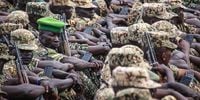Madaxweyne Donald Trump ayaa amray in ciidamada Mareykan ah loo diro magaalada Portland ee gobolka…

Somalia stabilisation force: Uganda troops answer call up
By Moses Muli
Published: April 29 2024, 6:43 PM
Ugandan authorities have confirmed that the country’s forces will remain in Somalia after the expiry, at the end of this year, of the current mandate of the African Union mission, but the other troop-contributing countries from the region, Kenya and Burundi, are yet to be invited into the arrangement.
It has been confirmed that the current troop-contributing countries want to be part of the security plan that will replace the African Union Transition Mission in Somalia (Atmis) on January 1, 2025, because they are already heavily invested in Somalia’s transition.
Nathan Mugisha, Uganda’s Deputy Head of Mission in Somalia, said Uganda Peoples Defense Forces (UPDF), who were the first boots on the ground in March 2007, will continue to deploy there as part of the proposed post-Atmis security arrangement.
“Uganda will be here in whatever form,” he told journalists in Mogadishu on April 17, adding that the new AU-led mission is being planned on the basis of the United Nations Security Council (UNSC) Resolution 2719, and revealing that “they [UNSC] have asked us to stay and we’ve said yes”.
The spokespersons of the Kenya and Burundi contingents could not confirm if their armies would maintain a presence in Somalia, saying it was too early to discuss the arrangement.
They indicated that the post-Atmis security framework is not up to their countries to decide but a process led by the Federal Government of Somalia.
After the collapse of Mohammed Siad Barre’s regime in 1991, Somalia became a failed state, wallowing in economic ruin, political turmoil and destruction stemming from a bloody conflict fueled by armed clan factions, religious extremism and later terrorism that even global powers tried but failed to stop.
Mugisha says this is the state of affairs into which Uganda led the way as the African Union’s peacekeeping mission, and other African countries followed suit, with Burundi sending in troops in December 2007, and later Kenya, Ethiopia and Djibouti joined the force that says it has now liberated 80 percent of Somali territory.
“Some people used to think that this mission was dead on arrival,” said Mugisha. “When the rest of the world was scared to set foot in Somalia, Uganda sent troops here.”
But al-Shabaab remains a threat, and with Atmis drawing down to 5,000 troops since June last year – while passing the baton to the Somali National Army – the enemy has regrouped and reclaimed lost territory in Galmudug and Hirshabelle.
Ugandan commanders under Atmis say that Somalia needs more time to generate a force that can defend its vast territory and that a security vacuum could arise when the mandate of Atmis ends on December 31, 2024.
In a recent interview with journalists, Uganda contingent commander Brig-Gen Anthony Lukwago alluded to open spaces that are left as the peacekeepers exited in the previous two drawdowns (June and December 2023), allowing al-Shabaab space to attack civilians.
“They are telling us to draw down, but we will still have a force on the ground. We are not about to create an Afghanistan here,” he said. “What happens to these places? The population will either become vulnerable to al-Shabaab attacks or subscribe to al-Shabaab. You can see the fix they are in.”
Another drawdown due in June this year will target 4,000 troops, of whom 1,000 will be Ugandans.
The AU force has just over 13,000 troops in Somalia, down from 22,000 at the peak of deployment. After the June drawdown, the mission will be down to 9,000 personnel.
Stakeholders, who include the Federal Government of Somalia, the UN, AU and international partners like the European Union, the US and Turkey, have proposed an AU-led multinational force to take over from Atmis.
The EU, a key partner in the rebuilding of the country’s security sector, has consistently warned that while drawdowns are taking place, the FGS has not achieved adequate force generation to replace the lost capacity of Atmis.
Brig-Gen Lukwago said that rebuilding Somalia’s security forces especially the army, has not matched the task at hand: “They haven’t really built an adequate force that can conduct operations, defend borders and secure the population from al-Shabaab.”
Within the diplomatic and security sectors, there are indications that the stabilisation force that will replace Atmis will focus on key centres such as Mogadishu, but experts punch holes in this strategy as defending from the rear, instead of attacking enemy bases.
For bilateral arrangements, continued deployment in Somalia under the new force will come with a new burden of demands and put a strain on TCCs budgets to provide funding to cover salaries and allowances for soldiers, the purchase of materiel, arms and ammunition.
UN-invited countries, on the other hand, will enjoy international partners’ support. The EU, for instance, has already indicated that although the scope and size of the stabilization force is not yet clear, Brussels is willing to provide funding for it.



This Post Has 0 Comments